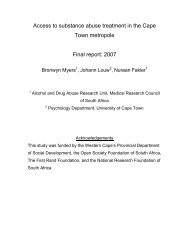Audit of Substance Abuse Treatment Facilities in ... - SA HealthInfo
Audit of Substance Abuse Treatment Facilities in ... - SA HealthInfo
Audit of Substance Abuse Treatment Facilities in ... - SA HealthInfo
- No tags were found...
You also want an ePaper? Increase the reach of your titles
YUMPU automatically turns print PDFs into web optimized ePapers that Google loves.
appropriate services for Black/African substance abusers. This is <strong>in</strong> keep<strong>in</strong>g with f<strong>in</strong>d<strong>in</strong>gsfrom previous audits <strong>of</strong> substance abuse treatment facilities (Myers & Parry, 2003;Myers, 2004; Myers & Fakier, 2007).Gender appropriateness <strong>of</strong> servicesAlthough substance abuse treatment services are under-utilised by women (Myers, Parry,& Plüddemann, 2004), few facilities <strong>in</strong> Free State, Limpopo, Mpumalanga, North Westand Northern Cape provide services aimed at address<strong>in</strong>g some <strong>of</strong> the barriers that preventwomen from engag<strong>in</strong>g and be<strong>in</strong>g reta<strong>in</strong>ed <strong>in</strong> treatment. These barriers <strong>in</strong>clude limitedresources to arrange for <strong>in</strong>dependent childcare (Booth & McLaughl<strong>in</strong>, 2000), and the lack<strong>of</strong> women-sensitive treatment programmes that focus on the special needs <strong>of</strong> women(such as domestic violence and sexual assault) (Booth & McLaughl<strong>in</strong>, 2000).This study found that although three quarter <strong>of</strong> facilities report provid<strong>in</strong>g genderappropriateand sensitive counsell<strong>in</strong>g services, a smaller proportion <strong>of</strong> facilities provideservices that address women’s issues (such as trauma and violence) and use genderappropriate assessment tools. Only 1 facility (<strong>in</strong> Mpumalanga) provides womenfocused/women-onlytreatment services. Only half <strong>of</strong> the facilities provide staff withspecial tra<strong>in</strong><strong>in</strong>g <strong>in</strong> gender-related issues that may be pert<strong>in</strong>ent to treatment (such asdomestic violence). It should be noted that even though facilities may report theprovision <strong>of</strong> women-sensitive services, this lack <strong>of</strong> tra<strong>in</strong><strong>in</strong>g <strong>in</strong> gender-related issues mayaffect the extent to which these services effectively address gender-specific issues, andultimately the retention <strong>of</strong> female substance abusers <strong>in</strong> treatment.While these f<strong>in</strong>d<strong>in</strong>gs represent an improvement on f<strong>in</strong>d<strong>in</strong>gs from previous audits <strong>of</strong>substance abuse treatment facilities <strong>in</strong> Gauteng (Myers, 2004), they are still cause forconcern as previous research has identified treatment facilities’ failure to have a gendersensitivetreatment approach as a factor that limits female clients engagement andretention <strong>in</strong> treatment (Booth & McLaughl<strong>in</strong>, 2000). In addition, these f<strong>in</strong>d<strong>in</strong>gs highlightthe need to provide treatment staff with tra<strong>in</strong><strong>in</strong>g on topics such as domestic violence,victimisation, and trauma that may be pert<strong>in</strong>ent to female substance abusers as well as theneed to provide staff with tra<strong>in</strong><strong>in</strong>g on gender-sensitive treatment approaches.75
















